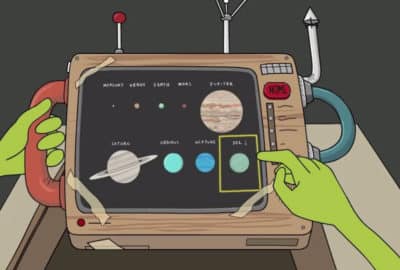A Quick Look Around the LHC
Thursday 12th Apr 2012, 4.15pm
The Large Hadron Collider may not work quite as seen in our animation, but much of the science mentioned is accurate. Here’s a little more background on exactly what’s going on.
Surrounded by cold magnets
The protons travel through more than 9,000 magnets on each lap of the Large Hadron Collider. The magnets bend the proton beams round in a circle, and focus them for collision. The largest magnets are 15 metres long, and are made of superconducting cable which has no electrical resistance at low temperatures. These special superconducting and superfluid properties of ultra-cold materials are why the magnets are designed to operate at -271.3°C, just 1.9 degrees above absolute zero, and colder than outer space. The field strength is 8 Tesla, which is about 100,000 times the Earth’s magnetic field.
7000 times heavier
In 1905, Einstein proposed a revolutionary idea – known as the “special theory of relativity”. Some of the surprising consequences of that theory are that a particle moving close to the speed of light will get heavier, will be squeezed in its length, and will even feel time slowing down. The apparent mass increases by a factor of (1-v2/c2)-1/2, where v is the speed of the particle and c = 299 792 458 m/s is the speed of light. This “Lorentz” factor is close to 1 for particles moving slowly compared to the speed of light, which is why we don’t notice relativistic effects in our daily lives. The particles in the LHC are traveling at speeds of 0.999999991 of the speed of light, making their apparent mass 7000 times as large as if they were static.
The collision
When high-energy particles – like our teams of protons – collide, part of their energy can be converted into the mass of new particles. What is produced is not just bits of protons – we also see neutrons, protons, electrons, as well as more exotic particles including pions, W and Z particles… in fact the whole zoo of elementary particles and their anti-particles is produced. No two collisions are the same, and so the LHC provides many events for its detectors to study, with team after team of protons being annihilated in the cause of science.
In the collision that takes place in the animation a “Higgs boson” particle being produced (look for the ‘H’ and the hat with the flower in it!). This very special particle is believed to play an important role in giving other particles mass. In the Standard Model of particle physics the Higgs field is found everywhere in space. It is theorised that all the particles in the Standard Model pick up their mass through interactions with this Higgs field. The Higgs boson is a particle created through the energetic excitation of this field.
Many of the particles produced at the Large Hadron Collider enjoy only a very brief existence. Most are unstable and decay within a fraction of a second into other, more stable particles. The Higgs boson is predicted to decay rapidly into other, better-known particles, such as W bosons and b-quarks. As well as Higgs bosons, we are looking for other evidence of unexpected physics – everything from new fundamental forces of nature, to differences between matter and anti-matter, and even new dimensions of space. Each of these phenomena has its own characteristic decay products and corresponding signatures inside the detector.
The detector apparatus
As different bits of particle debris fly out from the collision point, we need to be able to identify the type and properties of any new particles produced. The reconstruction of the original collision is a tricky job – it’s a bit like trying to understand how a grand piano works by throwing bricks at it, and seeing which bits fly out. By making many careful measurements of the resulting bits we can hope to understand the properties of even very short-lived particles.
There are four collision points around the LHC ring. Each of these four points is surrounded by sensitive detectors which record the passage of particles through them. The ATLAS detector is the largest. Measuring in at 25 meters in diameter and 44 meters long, it is a true underground giant.
In the animation, Ossie passes through three layers of detectors, which represent tracking detectors, before stopping with a crunch when he hits a brown-coloured corrugated object. This journey reflects those of longer-lived particles created inside ATLAS. The new particles pass through several precision tracking layers, which lie closest to the middle of the detector where the protons collide. Most particles pass through these layers, leaving a small deposit of energy if they are charged. The great majority of the particles is then stopped by the heavy materials in the calorimeter, a detector which is instrumented with liquid Argon and scintillators and which allows the particles’ energies to me measured.
The innermost, highest precision layers of the detector are instrumented with silicon detectors. Four such semiconductor layers register the passage of electrically charged particles as they pass through, each one creating a tiny electrical signal, which is picked up with sensitive electronics. The Oxford particle physics group assembled the central part of the semi-conductor tracker system at their laboratories in central Oxford. The completed silicon layers were shipped to CERN during 2005, where they were integrated with the other detectors from groups around the world. The tracker now lies at the heart of the ATLAS detector, where it plays a central role in the LHC physics programme.
The first results
Only a tiny fraction of the proton-proton collisions – about one in a billion – is expected to produce a Higgs boson, so billions of these collisions are needed to create enough Higgs particles to make meaningful measurements. In the Large Hadron Collider, the bunches of protons pass through each other up to 40 million times per second, with tens of collisions between individual protons each time. The same beams can be used for several hours before the machine has to be refilled with “fresh” protons.
It was precisely because of the sheer number of collisions that we were able to announce, in the summer of 2012, that a Higgs-like boson had indeed turned up in the LHC. The signals seen in both ATLAS and CMS, another detector, indicate the presence of a particle that has properties that are consistent with those expected from the Higgs. Each experiment on its own has observed a significant enough detection to meet the gold standard of confidence for the discovery of a new particle. We’re not done, though – it will take time to be sure whether or not the particle discovered really is the Higgs, and the LHC may well have more surprises in store. It has generated less than 1% of the total data it will eventually provide, and there is a lot more work to do!
Further information:
Teaching Resources:
KS3: Footprints of the Higgs Boson
Find out more:
Oxford’s physics research site
Oxford’s Collider App for iOS and Android
LHC resources from the Science and Technology Facilities Council
Voltaire Lecture 2010 – Prof Brian Cox on ‘The Value of Big Science’
BlueSci Film – Large Hadron Collider





